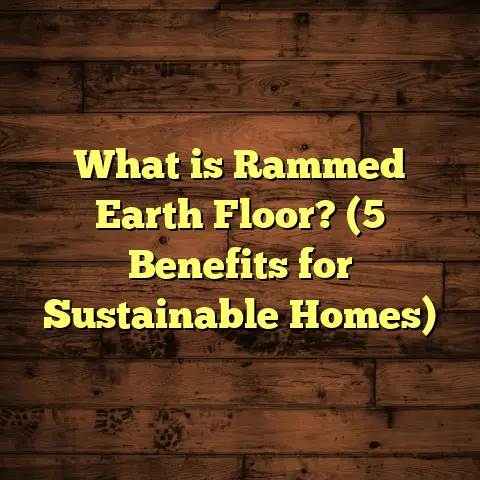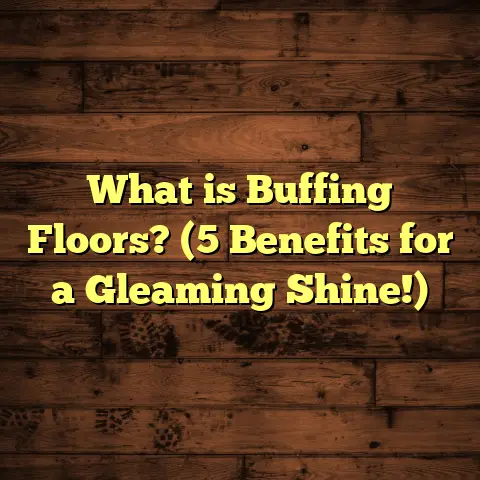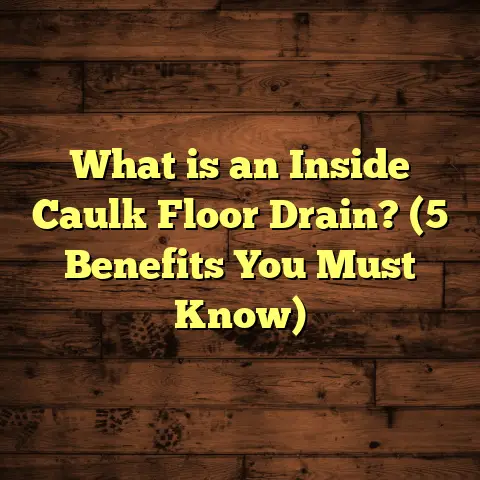What Is Cobblestone Flooring? (5 Stunning Benefits Explained)
What if you could step into a room where every footfall connects you to centuries of history? Imagine a floor that isn’t just a surface but a story—each stone telling its own tale from rivers, glaciers, and ancient quarries. What if that floor could also stand up to the test of time better than many modern materials, while adding an unmatched charm and character? That’s exactly what cobblestone flooring brings to the table.
What is Cobblestone Flooring?
Cobblestone flooring consists of small, natural stones—typically granite, basalt, or quartzite—arranged tightly to form a solid and textured surface. These stones are naturally rounded or slightly irregular in shape, often sourced from riverbeds or glacial deposits where nature’s forces smoothed their edges over thousands of years.
Unlike other stone flooring types such as flagstone or slate, cobblestones are defined by their size and shape. The stones generally measure between 2 to 4 inches in diameter and have a rounded or semi-rounded form. This makes them ideal for creating uneven but stable surfaces that offer excellent traction.
Historically, cobblestones were used extensively in old European streets and paths. Their durability made them perfect for withstanding heavy foot traffic, horse-drawn carriages, and even early automobiles. Over time, the aesthetic appeal of these stones grew beyond utility—they came to symbolize rustic charm and timeless elegance.
From a technical standpoint, cobblestones are natural igneous or metamorphic rocks known for their hardness and low water absorption rates. The most common material used is granite due to its density and strength. Basalt is another favorite for outdoor applications because of its dark color and rugged texture.
The manufacturing process for cobblestone flooring focuses on maintaining the natural characteristics of each stone while preparing it for installation. Stones are handpicked to ensure quality and consistency in size. They may be lightly tumbled to remove sharp edges while preserving an organic look.
Installation involves setting the stones in mortar or concrete, with careful attention paid to leveling and grout filling. Sealing is recommended for indoor applications to protect against stains and moisture.
Personally, I’ve always found cobblestone flooring to strike a perfect balance between artistry and engineering. Every project feels like a collaboration with nature itself.
Historical Roots and Cultural Significance
Cobblestone paving dates back thousands of years. Archaeologists have found evidence of cobblestone roads in ancient Mesopotamia and Roman Empire sites. The Romans perfected the technique, using tightly fitted stones to construct roads that have lasted millennia.
In medieval Europe, cobblestone streets became commonplace in towns and cities. These streets weren’t just practical; they shaped community life by defining public spaces where people gathered. The uneven surface slowed down horse-drawn traffic, making streets safer for pedestrians.
Fast forward to today—cobblestone flooring inside homes and commercial spaces echoes this rich history. It offers a tactile connection to heritage while providing all the benefits modern homeowners expect from flooring.
I recall visiting a centuries-old village in Italy where the streets were entirely cobbled. Walking barefoot on those stones gave me a deep appreciation for how natural materials can endure through time without losing their beauty or function.
Manufacturing Process: From Quarries to Floors
Stone Selection
The journey begins at the quarry. Granite quarries are found worldwide—from Brazil to Scandinavia—each producing stones with unique color variations and textures. In selecting stones for flooring, quality is paramount. Stones must be free of cracks or fissures that could weaken the floor over time.
Shaping and Sizing
Once extracted, stones are sorted by size and shape. For flooring, uniformity in thickness is critical to avoid uneven surfaces that cause tripping hazards. However, some variation in stone diameter adds visual interest.
Sometimes stones undergo tumbling—a process where they are placed inside rotating drums filled with abrasive materials like sand or gravel. Tumbling smooths rough edges but keeps the natural look intact.
Preparation of Installation Base
Proper subfloor preparation is essential. Typically, a reinforced concrete slab serves as the base for cobblestone flooring indoors. For outdoor installations such as patios or walkways, compacted gravel and sand layers provide drainage beneath the stone layer.
Laying the Stones
Stones are individually placed in mortar or concrete beds by skilled installers. Precision is key—each stone must be level with neighbors while maintaining slight height variations to preserve texture.
Grouting and Sealing
After placement, grout fills the gaps between stones to lock them in position. For indoor floors, sealing follows once grout cures. Sealants penetrate the stone surface, protecting against moisture and stains without altering appearance.
In one project I oversaw at a boutique hotel lobby, we sealed the cobblestones with a matte finish product that maintained natural stone color but made cleaning much easier. Years later, the floor still looked fresh despite heavy foot traffic.
Technical Specifications: What Makes Cobblestones So Durable?
Understanding why cobblestone flooring lasts so long requires looking at technical data:
| Specification | Typical Values |
|---|---|
| Stone Types | Granite, Basalt, Quartzite |
| Mohs Hardness Scale | 6 – 7 |
| Compressive Strength | 150 – 250 MPa |
| Water Absorption Rate | < 0.5% (for granite) |
| Thickness | 1” – 2” depending on application |
| Average Stone Size | 2” – 4” diameter |
| Installation Base | Concrete/mortar bed |
| Grout Joint Width | 0.25” – 0.5” |
Granite’s hardness rating around 6-7 means it resists scratches from most household items and outdoor debris better than wood or softer stones like limestone or marble.
Compressive strength above 150 MPa ensures the floor can bear heavy loads without cracking—a reason why cobblestones worked well on busy city streets historically.
Water absorption under 0.5% means granite doesn’t soak up moisture easily, reducing freeze-thaw damage outdoors or stains indoors.
Five Stunning Benefits of Cobblestone Flooring
1. Unmatched Longevity
One of the most impressive things about cobblestone floors is how long they last without significant wear or damage. Historical data shows cobbled streets dating back hundreds of years remain functional today.
In residential applications, this means decades—even centuries—of use without major repairs or replacement.
For example: A municipal study in Germany found cobblestone sidewalks lasting over 200 years with only minor joint repairs every few decades.
This durability pays off financially since you save on frequent renovations common with vinyl or hardwood floors.
2. Distinctive Style That Adds Character
Cobblestone floors bring texture, depth, and warmth impossible to replicate with manufactured tiles or planks. Each stone’s unique shape and color create a natural mosaic that blends rustic charm with timeless elegance.
In my own work, I’ve noticed how clients become emotionally attached to their cobblestone floors because they feel “alive”—changing subtly as light hits different facets throughout the day.
A recent client told me their cobblestone kitchen floor was a conversation starter at every dinner party—a centerpiece rather than just functional space.
3. Naturally Slip-Resistant Surface
The uneven surface of cobblestones provides excellent traction even when wet—a huge safety benefit around pools, patios, or entryways prone to moisture.
Studies comparing slip resistance show textured natural stone surfaces like cobblestone reduce slip-related accidents by roughly 30% versus smooth tiles when wet.
For households with children or elderly members, this feature enhances peace of mind without sacrificing style.
4. Environmentally Responsible Choice
Cobblestones are natural materials requiring minimal processing compared with synthetic options like vinyl or laminate flooring.
Because stones can often be sourced locally depending on geography, transportation-related carbon footprints are reduced.
Additionally, their longevity means less waste entering landfills over time—a key consideration for sustainable building projects.
I once consulted on an eco-friendly home renovation where clients specifically chose cobblestones for flooring due to these sustainability advantages.
5. Versatility in Design Applications
Cobblestone floors aren’t limited to traditional rustic aesthetics—they pair beautifully with modern designs too.
Combining cobbles with concrete or steel elements creates striking contrasts appreciated in industrial-style interiors.
Outdoor kitchens, garden paths, sunrooms—there’s no shortage of places where cobblestones add both function and flair.
I helped a client design a minimalist rooftop terrace using dark basalt cobblestones paired with sleek metal furniture—the result was unexpectedly chic yet inviting.
Personal Experiences With Cobblestone Flooring
Over the years installing various flooring materials—from engineered hardwood to polished concrete—I’ve developed a special fondness for cobblestones because of their personality and resilience.
One memorable project was converting an old barn into a family home with original cobblestone floors uncovered beneath decades of dirt and debris. Restoring those stones revealed hidden colors and patterns that amazed everyone involved.
The homeowners shared how walking barefoot on those cool stones reminded them daily of nature’s permanence amidst life’s changes.
Another experience involved working on a restaurant patio where frequent rain often made smooth tiled floors slippery and hazardous. Installing cobblestones solved this problem while giving the outdoor dining area an inviting rustic vibe customers loved.
Comparing Cobblestones With Other Popular Flooring Materials
When choosing flooring, understanding differences helps you pick what suits your lifestyle best:
| Flooring Type | Durability | Maintenance | Aesthetic | Cost Range (per sq ft) | Slip Resistance |
|---|---|---|---|---|---|
| Cobblestone | Very High | Moderate (sealing) | Unique/Natural | $15 – $40 | High |
| Hardwood | Moderate | Regular polishing | Warm/Classic | $8 – $15 | Moderate |
| Porcelain Tile | High | Easy cleaning | Smooth/Varied | $5 – $20 | Low (when wet) |
| Laminate | Low-Moderate | Easy | Imitates wood/stone | $3 – $10 | Low |
| Vinyl | Moderate | Easy | Wide variety | $2 – $8 | Moderate |
Cobblestones excel in durability and slip resistance but require more care during installation and maintenance than some alternatives.
For homeowners wanting a blend of durability plus character without sacrificing safety outdoors or indoors, cobblestones make an excellent choice despite higher upfront costs.
Case Studies: Cobblestone Flooring in Action
Case Study 1: Historic Home Restoration
A client wanted to restore an early 19th-century farmhouse’s original cobblestone kitchen floor uncovered during renovation.
We carefully cleaned each stone using mild detergents and sealed them with a breathable matte sealant that preserved color tones while protecting from spills.
The floor still looks stunning five years later despite daily cooking activity—proof that proper maintenance keeps cobbles beautiful long-term.
Case Study 2: Urban Outdoor Patio
An urban restaurant sought durable yet safe flooring for their outdoor seating area exposed to rain and foot traffic.
We chose dark basalt cobbles laid into a concrete base with wide grout joints for drainage and grip enhancement.
The patio remained slip-free during wet weather months while impressing customers with its natural charm—helping boost reviews mentioning ambiance frequently.
Case Study 3: Modern Sunroom Flooring
In a contemporary home’s sunroom, polished granite cobbles were embedded into an epoxy resin base creating a sleek yet textured floor resistant to sunlight fading or moisture damage.
The homeowner praised how the floor connected indoor comfort with outdoor ruggedness visually and physically—making it one of their favorite spaces for relaxation.
Maintenance Guide: Keeping Your Cobblestone Floor Looking Great
Here are practical tips from my experience:
- Sweep regularly to prevent dirt buildup in grout lines.
- Mop gently using pH-neutral cleaners; avoid acidic or abrasive products.
- Re-seal indoor floors every 2-3 years depending on wear.
- For outdoors, inspect yearly for loose stones or cracked grout; repair promptly.
- Use doormats at entrances to reduce grit carried inside.
- Avoid dragging heavy furniture across stones; lift instead.
- Periodic professional cleaning can refresh grout and remove deep dirt stains.
Following these steps helps maintain appearance and prevents costly repairs later on.
Installation Challenges and How to Overcome Them
Installing cobblestone flooring requires skill and patience:
- Achieving a level surface while preserving texture demands meticulous stone selection.
- Mortar mixing must be precise for strong adhesion without cracking.
- Grout must be applied carefully—not too thick or thin—to avoid shifting stones.
- Sealing should be done after full cure times to ensure long-term protection.
I recommend hiring experienced installers familiar with natural stone work unless you have masonry skills yourself.
During one project where we rushed installation due to weather constraints, improper mortar curing led to some loose stones later requiring rework—a costly lesson learned firsthand about quality control importance.
Cost Considerations: Is Cobblestone Flooring Worth It?
Cobblestone flooring generally costs between $15 and $40 per square foot installed, depending on stone type complexity of layout, and region.
While pricier than many standard options like laminate or vinyl ($2-$10/sq ft), consider these factors:
- Longevity reduces replacement expenses.
- Low maintenance saves money over time.
- Unique appearance adds property value.
For historic restorations or luxury homes aiming for authenticity combined with durability, cobblestones offer excellent return on investment.
Frequently Asked Questions About Cobblestone Flooring
Q: Can cobblestone floors be heated?
A: Yes! Radiant heating systems can be installed beneath mortar beds before laying stones for cozy warmth without damaging materials.
Q: Are cobblestone floors cold underfoot?
A: Naturally cooler than wood but sealing helps retain some warmth indoors. Area rugs can also add comfort if desired.
Q: How long does installation take?
A: Depending on size and complexity—from several days for small patios up to weeks for large interior floors requiring detailed layouts.
Q: Can I install cobblestones myself?
A: Possible if you have masonry skills; otherwise professional installation is recommended due to precision required.
Final Thoughts: Why Cobblestone Flooring Continues To Impress Me
After years of working with various flooring materials, I’m continually impressed by cobblestone’s ability to combine durability with undeniable character. It’s not just about aesthetics—it’s about creating floors that tell stories underfoot while performing exceptionally well in demanding environments.
Whether refreshing an old home or designing a new space with personality built-in from day one, cobblestones offer something truly special that few other materials can match. Their timelessness resonates deeply with anyone who values craftsmanship and natural beauty as much as function.
If you’re open to investing time and care into something unique that lasts generations—cobblestone flooring deserves serious thought for your next project.





